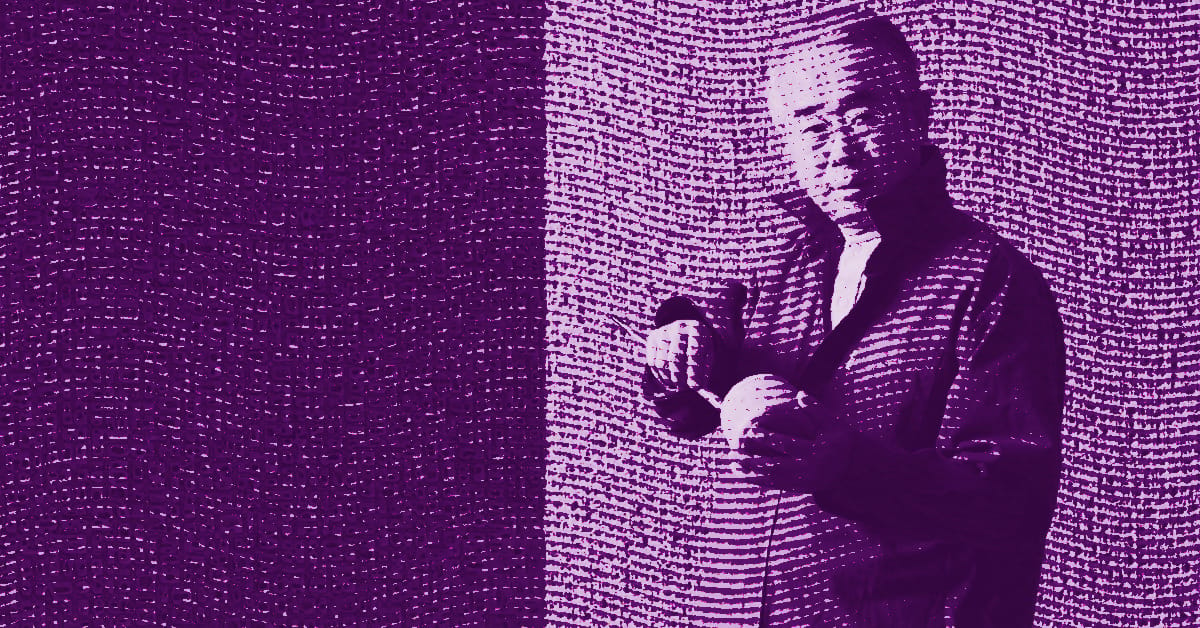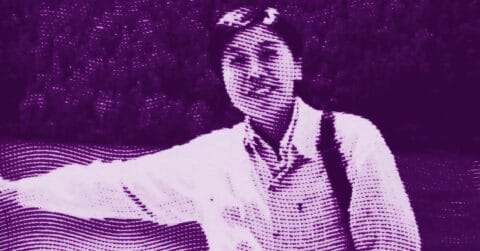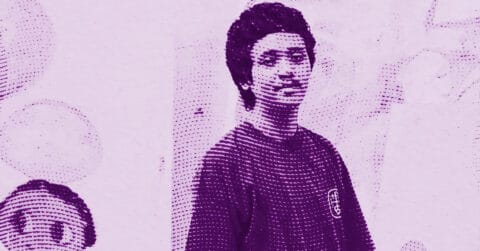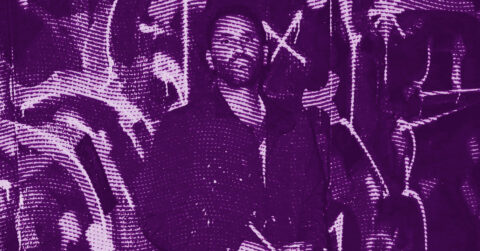Listen to me carefully, you bunch of snobs: while you get lost in your laborious debates about the future of contemporary art, Kim Tae-Ho spent nearly forty-five years of his life building, layer after layer, one of the most authentically revolutionary bodies of work in contemporary Korean art. This man, born in Busan in 1948 and prematurely deceased in 2022, did not just participate in the Dansaekhwa movement, he rethought it, surpassed it, and propelled it toward unexplored territories where painting becomes sculpture, where time materializes into colored strata, where each repetitive gesture resonates like a meditation on human existence.
Kim Tae-Ho’s work, particularly his emblematic series Internal Rhythm (Internal Rhythm), remains one of the most accomplished realizations of what one might call a “pictorial architecture.” This expression is no accident: it reveals the deep kinship between the Korean artist’s approach and the spatial methodology of Japanese architect Tadao Ando, the undisputed master of manipulating space and light in contemporary architecture.
Sacred geometry: When art meets architecture
The analogy between Kim Tae-Ho and Tadao Ando [1] goes beyond mere geographic or temporal coincidence. These two creators share a common obsession with transforming raw materials, concrete for Ando and acrylic paint for Kim, into spaces of contemplation and revelation. For the Japanese architect, concrete walls are never mere partitions but interfaces allowing subtle dialogue between interior and exterior, between light and shadow. His creations, from the Church of the Light to the Water Temple, reveal mastery of space that transforms every architectural path into a spiritual experience.
This same spatial philosophy animates Kim Tae-Ho’s work. His meticulously constructed grids are not merely decorative motifs but true miniature architectures. Each cell of the grid functions as an autonomous chamber, an intimate space where colors unfold according to their own internal logic. The Korean artist’s creative process directly evokes Ando’s construction methods: patient accumulation of materials, obsessive attention to technical details, pursuit of formal perfection that never sacrifices emotion to cold geometry.
The influence of architecture on Kim Tae-Ho is not limited to a simple metaphorical analogy. The artist himself expressed fascination with urban structures, particularly the metal shutters of shops that inspired his first Form series in the 1970s. These banal architectural elements become, under his brush, sophisticated explorations of the tension between revelation and concealment, between surface and depth. This approach remarkably prefigures Ando’s philosophy, for whom architecture must create “zones of individuality within society,” spaces for retreat and meditation in an increasingly standardized world.
The layering technique developed by Kim Tae-Ho in his Inner Rhythm series can be understood as a pictorial transposition of Ando’s constructive methods. The Japanese architect uses concrete not as a filling material but as a poetic substance, capable of capturing and reflecting light with an almost textile sensitivity. Kim Tae-Ho proceeds similarly with his layers of acrylic: each stratum becomes a structural element of the work, contributing to building a virtual space where the gaze can get lost and find itself. Light, for both creators, is not a mere lighting agent but a sculptural material in its own right.
This kinship is also expressed in their conception of time. Ando conceives his buildings as living organisms that evolve according to the hours and seasons, revealing unexpected aspects depending on the angle of the light or the observer’s position. Kim Tae-Ho achieves a similar effect through the temporal accumulation of his gestures: each layer of paint carries within it the trace of elapsed time, creating an emotional stratigraphy that the viewer gradually discovers. The “little chambers” of his grids evoke Ando’s contemplative spaces, those places of gathering where architecture becomes discreet to better reveal the essential.
Kim Tae-Ho’s work thus dialogues with an architectural tradition that transcends national borders to question the foundations of spatial experience. Just as Ando transforms simple geometric volumes into cathedrals of light, the Korean artist metamorphoses repetitive gestures into intimate architectures, creating meditation spaces that exist only in the encounter between the work and the gaze that contemplates it.
The phenomenology of matter: Heidegger’s legacy
The philosophical dimension of Kim Tae-Ho’s work cannot be fully apprehended without reference to Martin Heidegger’s thought [2], particularly his meditation on being, time, and art. The German philosopher, in his essay “The Origin of the Work of Art,” develops a revolutionary conception of artistic creation as a “bringing-forth of truth,” a process by which being unveils itself in its most authentic dimension. This approach strikingly illuminates Kim Tae-Ho’s process, each of his works constituting a genuine archeology of presence.
Heidegger distinguishes between the manufactured object (Zeug) and the work of art (Kunstwerk), emphasizing that the latter does not merely represent the world but brings it forth in its truth. Kim Tae-Ho’s paintings perfectly illustrate this distinction: far from being mere decorative objects, they function as revealers of temporality, making visible the very process of their elaboration. Each scrape with the knife reveals buried layers, actualizing what Heidegger terms Unverborgenheit, the unveiling of what was hidden.
Heidegger’s notion of Dasein (being-there) finds a particularly eloquent translation in Kim Tae-Ho’s art. Dasein designates this specifically human way of existing in time, always already projected toward the future while carrying the weight of the past within itself. The works of the Inner Rhythm series materialize this existential temporality: each layer of paint corresponds to a lived moment, an “ecstasy of time” to borrow Heidegger’s vocabulary, and their superposition creates a stratigraphy of being that makes perceptible the historical dimension of all existence.
Kim Tae-Ho’s technical approach, this meticulous alternation between accumulation and subtraction, directly evokes Heidegger’s dialectic between Anwesenheit (presence) and Abwesenheit (absence). Each scraping gesture makes part of the pictorial matter disappear while revealing the underlying layers, actualizing this fundamental paradox according to which every revelation simultaneously implies an occultation. This dynamic transcends mere technique to become a meditation on the conditions of possibility for any appearance.
The repetitiveness of the Korean artist’s gestures can be understood as a form of Heidegger’s Wiederholung, not a simple mechanical repetition but an “authentic reprise” that allows each moment to reveal its singularity. Kim Tae-Ho never reproduces exactly the same gesture: each layer, each scraping carries within it its own necessity, its own truth. This approach transforms the creative act into an exercise of existential authenticity, allowing the artist to escape the dictate of “one” (das Man) in order to access truly personal creativity.
Kim Tae-Ho’s work also reveals an intuitive understanding of what Heidegger calls the “squaring” (Geviert), that original articulation between earth and sky, mortals and divines. His paintings are never pure aesthetic objects but cosmological condensates where different dimensions of experience articulate. The materiality of the painting evokes the earth, its luminosity varying according to the lighting recalls the sky, the time of their elaboration testifies to the artist’s mortal condition, and their capacity to arouse wonder opens toward a dimension that surpasses the overly human human.
This cosmological dimension is particularly expressed in the metaphor of the “beehive” often associated with Kim Tae-Ho’s works. Each cell of the grid functions as an autonomous microcosm, but the whole forms a complex organism where invisible forces circulate. This structure evokes Heidegger’s conception of the world as an articulated totality, where each being finds its place in a network of meanings that surpass it while constituting it.
Heidegger’s influence on Kim Tae-Ho must not be understood as a mechanical application of a philosophical system but as a spontaneous convergence toward fundamental questions. 20th-century Korean art, particularly the Dansaekhwa movement, bears witness to a philosophical sensitivity that naturally joins Heidegger’s concerns: questioning the essence of art, meditation on time and finitude, search for creative authenticity in a world dominated by technique. Kim Tae-Ho’s work is part of this confluence, achieving through painting what Heidegger sought to formulate conceptually: a thought of being that is also a poetics of existence.
The legacy of gesture: Between tradition and innovation
Kim Tae-Ho developed his artistic singularity in a cultural context where the tradition of repetitive gesture occupies a central place. Korean art, deeply imbued with Buddhist and Confucian philosophies, has always favored the exercise of patience and the pursuit of perfection through repetition. This approach finds in the works of the Inner Rhythm series a remarkably modern actualization, where traditional gesturality meets contemporary aesthetic concerns.
The technique developed by the artist, layering more than twenty coats of acrylic paint followed by their meticulous scraping, reveals a technical mastery that evokes the great artisans of Korean ceramics. This kinship is not accidental: it bears witness to a cultural continuity that spans centuries, adapting ancestral wisdom to contemporary aesthetic challenges. Kim Tae-Ho does not break with Korean tradition; he reinvents it, propelling it into unexplored territories where it can engage on equal terms with international art.
Kim Tae-Ho’s creative process transforms each work into a temporal testimony where moments of its creation are superimposed. This stratification reveals a conception of time that radically departs from Western linear temporality to embrace a cyclical approach more in line with Asian philosophies. Each scraping reveals earlier layers without entirely erasing them: they remain present, influencing the upper layers simply by their existence. This coexistence of temporalities transforms each painting into a condensed history, a sensitive archive where the past continues to act on the present.
The meditative dimension of Kim Tae-Ho’s work cannot be underestimated. The artist himself spoke of this contemplative quality in his creative process, describing how the repetition of gestures led him to a state of concentration that surpassed mere technical application to become a spiritual exercise. This approach places his work in the lineage of Asian meditative practices, where rhythmic repetition allows access to altered states of consciousness. Each brushstroke thus becomes a meditation gesture; each scraping, a form of secular prayer.
This spiritual dimension does not stem from superficial mysticism but from a rigorously materialist approach to creation. Kim Tae-Ho does not seek to escape the sensible world but to reveal its hidden potentialities. His technique of layering and progressive revelation evokes traditional alchemical methods, where the transformation of matter implies a parallel transformation of the operator. The artist does not remain external to his work but participates in its metamorphosis, willingly being changed by the very process he initiates.
Towards an aesthetics of revelation
Kim Tae-Ho’s work today stands as one of the most significant accomplishments of contemporary Korean art, not despite its apparent modesty but because of it. In an art world often dominated by emphasis and spectacular excess, his paintings offer an alternative path: that of patient deepening, of meticulous exploration of the infinite possibilities contained within limited means. This approach reveals an aesthetic wisdom that far exceeds the concerns specific to contemporary art to question the very conditions of human experience.
The Rythme Intérieur series thus constitutes much more than a simple body of work: it proposes a true philosophy of creation that reconciles the Korean cultural heritage with the demands of artistic modernity. Kim Tae-Ho has avoided the dual pitfalls of sterile traditionalism and superficial Westernization to invent an authentically personal plastic language, rooted in his native culture while remaining open to external influences. This remarkable synthesis makes him one of the most accomplished representatives of what might be called a “creative globalization,” where intercultural exchange enriches local particularities instead of leveling them.
Kim Tae-Ho’s influence on the generations of artists who succeeded him testifies to the relevance of his approach. His conception of art as an exercise in patience and progressive revelation continues to inspire creators concerned with rediscovering an authentic creative temporality in a world dominated by constant acceleration. This influence is not limited to Korean borders but radiates internationally, contributing to redefining the terms of the dialogue between tradition and modernity in contemporary art.
Kim Tae-Ho’s premature passing in 2022 deprived the art world of a singular voice at the very moment when his research was beginning to receive the international recognition it had long deserved. His latest works showed an increasing freedom in the use of color and a complexification of his compositional structures that hinted at promising developments. This abrupt interruption transforms his body of work into an aesthetic testament, a closed set inviting meditation on completion and incompletion in art.
Kim Tae-Ho’s work reminds us that true art is not measured by its capacity for immediate seduction but by its power of progressive revelation. His paintings demand time, patience, sustained attention that stands in radical opposition to contemporary modes of artistic consumption. This requirement also constitutes their strength: they offer an aesthetic experience that resists the wear of time, revealing itself increasingly rich as one delves deeper. In this, Kim Tae-Ho joins the lineage of great creators who were able to transform the apparent limitations of their means into sources of inexhaustible invention.
Kim Tae-Ho’s art ultimately teaches us that true artistic innovation does not come from spectacular rupture but from the patient deepening of possibilities offered by simple means. His meticulous grids, his layered colors, his revealing scrapes are all invitations to rediscover the infinite richness contained in the most elementary gestures of creation. This lesson in creative humility resonates with particular acuity in our era of artistic overproduction, reminding us that authenticity is not decreed but conquered through the repeated exercise of uncompromising demand.
Kim Tae-Ho bequeathed us a body of work that functions as a mirror of our own creative possibilities. His paintings do not merely offer us an aesthetic spectacle: they invite us to discover in ourselves that patience, that attention, that capacity for deepening which constitute the true foundations of all authentic creation. This educational dimension, in the noblest sense of the term, ensures his work a longevity that far exceeds the fluctuations of the art market or passing critical fashions. Kim Tae-Ho thus enters that rare category of creators whose influence continues to grow after their passing, enriching our understanding of what art can and must be in a world in perpetual transformation.
- Tadao Ando, winner of the Pritzker Architecture Prize in 1995, a contemporary Japanese architect recognized for his concrete constructions and mastery of natural light in architectural space.
- Martin Heidegger, The Origin of the Work of Art (1935-36), in Paths That Do Not Lead Anywhere, Gallimard editions, 1962.
















